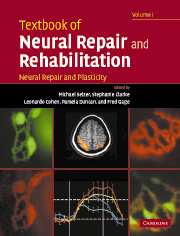Book contents
- Frontmatter
- Contents
- Contents (contents of Volume II)
- Preface
- Contributors (contributors of Volume I)
- Contributors (contributors of Volume II)
- Neural repair and rehabilitation: an introduction
- Section A Neural plasticity
- Section A1 Cellular and molecular mechanisms of neural plasticity
- Section A2 Functional plasticity in CNS system
- Section A3 Plasticity after injury to the CNS
- Section B1 Neural repair
- Section B2 Determinants of regeneration in the injured nervous system
- Section B3 Promotion of regeneration in the injured nervous system
- Section B4 Translational research: application to human neural injury
- Index
Neural repair and rehabilitation: an introduction
Published online by Cambridge University Press: 05 March 2012
- Frontmatter
- Contents
- Contents (contents of Volume II)
- Preface
- Contributors (contributors of Volume I)
- Contributors (contributors of Volume II)
- Neural repair and rehabilitation: an introduction
- Section A Neural plasticity
- Section A1 Cellular and molecular mechanisms of neural plasticity
- Section A2 Functional plasticity in CNS system
- Section A3 Plasticity after injury to the CNS
- Section B1 Neural repair
- Section B2 Determinants of regeneration in the injured nervous system
- Section B3 Promotion of regeneration in the injured nervous system
- Section B4 Translational research: application to human neural injury
- Index
Summary
Among medical specialties, rehabilitation has been one of the slowest to develop a basic science framework and to establish evidence-based practices as its norms. The reasons for this relate in part to the urgent need for clinical service and the dearth of experienced practitioners in the field during its formative years. It is imperative now, that the perceived lack of a scientific basis be reversed in order for rehabilitation medicine to achieve its full academic recognition and fulfill its great potential for relieving human suffering. This book represents an attempt to place the practice of neurorehabilitation in a rigorous scientific framework. Precisely because the need and the potential are so great, the editors have devoted equal space and emphasis to the clinical practice of neurorehabilitation and to its basic science underpinnings. In particular, two areas of basic science are highlighted – neuroplasticity and neural repair. In this respect, the book differs from most clinical textbooks. However, the professional neurorehabilitation community has been especially supportive of this direction and has taken very active steps to further the development of a basic scientific underpinning for its field. Similarly, the field of rehabilitation medicine, and in particular neurorehabilitation, has begun to put great emphasis on the development of evidence-based medical practices (DeLisa et al., 1999; Ottenbacher and Maas, 1999; Practice PPoE-B, 2001). The chapters in the clinical sections of this book stress those therapies for which evidence exists based on controlled clinical trials.
Keywords
- Type
- Chapter
- Information
- Textbook of Neural Repair and Rehabilitation , pp. xxvii - xxxviPublisher: Cambridge University PressPrint publication year: 2006

